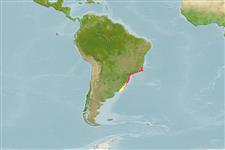Common names from other countries
Environment: milieu / climate zone / depth range / distribution range
Ecología
marino asociado a arrecife; rango de profundidad 0 - ? m (Ref. 40849), usually 0 - 15 m (Ref. 40849). Subtropical; 20°S - 35°S
Western Atlantic: Southern Florida, (USA), Bahamas, Antilles, and coast of South America (Ref. 26938), from Brazil to Argentina (Ref. 3815).
Length at first maturity / Tamaño / Peso / Age
Maturity: Lm 20.3, range 20 - 23.1 cm
Max length : 37.8 cm TL macho / no sexado; (Ref. 57473); peso máximo publicado: 2.5 kg (Ref. )
Short description
Claves de identificación | Morfología | Morfometría
Espinas dorsales (total) : 12; Radios blandos dorsales (total) : 13 - 14; Espinas anales: 3; Radios blandos anales: 12 - 14. Large, black, saddle-shaped blotch on upper caudal peduncle (Ref. 26938). Silvery, about nine faint narrow dark bars may be visible on upper two-thirds of body (Ref. 13442).
Occur in clean turbulent waters along open rocky coasts, usually in surf areas (Ref. 7251). Juveniles are frequently found in littoral pools between rocks (Ref. 9626). Individuals up to 10 cm are caught in shallow waters, often in sandy shores or in seagrass (Thalassia) beds (Ref. 9626). Maximum weight of 2500 g based on confirmed reports from Uruguay (L.A. Pereira, pers. comm., 6/12/01).
Life cycle and mating behavior
Maturities | Reproducción | Spawnings | Egg(s) | Fecundities | Larva
Cervigón, F., 1993. Los peces marinos de Venezuela. Volume 2. Fundación Científica Los Roques, Caracas,Venezuela. 497 p. (Ref. 9626)
IUCN Red List Status (Ref. 130435)
CITES (Ref. 128078)
Not Evaluated
Threat to humans
Harmless
Human uses
Pesquerías: escaso valor comercial; pesca deportiva: si
Herramientas
Special reports
Download XML
Fuentes de Internet
Estimates based on models
Preferred temperature (Ref.
115969): 21.1 - 25.8, mean 23.4 (based on 68 cells).
Phylogenetic diversity index (Ref.
82804): PD
50 = 0.5000 [Uniqueness, from 0.5 = low to 2.0 = high].
Bayesian length-weight: a=0.01230 (0.00574 - 0.02638), b=3.04 (2.87 - 3.21), in cm Total Length, based on LWR estimates for this Genus-body shape (Ref.
93245).
Nivel trófico (Ref.
69278): 3.1 ±0.39 se; based on food items.
Resiliencia (Ref.
120179): Medio, población duplicada en un tiempo mínimo de 1.4-4.4 años (Preliminary K or Fecundity.).
Fishing Vulnerability (Ref.
59153): Low to moderate vulnerability (28 of 100).
Climate Vulnerability (Ref.
125649): Moderate to high vulnerability (51 of 100).
